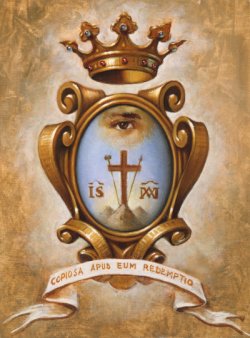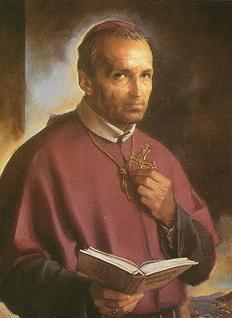Sacred Heart of Jesus Parish
205 Second Ave. N
Seattle, WA 98109
Office Phone: (206)284-4680
Office FAx: (206)284-3161
info@sacredheartseattle.com
|
| Congregation of the Most Holy
Redeemer |
|
The Congregation
of the Most Holy Redeemer:
-
A religious congregation
of men.
Priests and brothers.
-
Founded in 1732 by Saint Alphonsus Liguori.
-
Mission:To
spread the Gospel
to the poor and most abandoned.
-
C.Ss.R.
stands for Congregatio Sanctissimi Redemptoris,
"Congregation of the Most Holy Redeemer".
-
Started
apostolic work in the hill country
surrounding Naples, in southern Italy.
-
Expanded
ministry outside of Italy in 1735 with Clement Hofbauer
and Thaddeus Heubl in Austria.
-
Extended
to America in 1830.
-
Over
5,500 Redemptorists today.
-
Over 800
Redemptorists in USA and Canada.
|
 Copiosa Apud
Eum Redemptio
Copiosa Apud
Eum Redemptio |
| St.Alphonsus Liguori, founder
of the Redemptorists |
The founder of the Redemptorists, St. Alphonsus, was born near Naples on
September 27, 1696. Alphonsus studied in the University of Naples and
graduated as a Doctor of Civil and Church Law. He practiced with
outstanding success in the Neapolitan courts for ten years but he
abandoned his legal career owing to a grievous disappointment over an
important case that he lost, probably due to a bribed judge.
 He fell into a depression
and, at his recovery, he spent his time caring for prisoners and the
incurably sick. During one hospital visit, he had a profound religious
experience that led to his decision to become a priest. While still a
seminarian, he became a member of a society of secular priests and
seminarians dedicated to preaching missions (revivals) in parishes.
After his ordination he continued this work and also began to form small
communities of laity in the poorest
districts of Naples who regularly gathered for mutual spiritual support.
He fell into a depression
and, at his recovery, he spent his time caring for prisoners and the
incurably sick. During one hospital visit, he had a profound religious
experience that led to his decision to become a priest. While still a
seminarian, he became a member of a society of secular priests and
seminarians dedicated to preaching missions (revivals) in parishes.
After his ordination he continued this work and also began to form small
communities of laity in the poorest
districts of Naples who regularly gathered for mutual spiritual support.
At the earnest request of his spiritual
director, Bishop Tommaso Falcoia, Alphonsus helped and encouraged Sister
Maria Celeste Crostarosa and the other nuns of a convent in Scala (a
town overlooking the Amalfi coast) in inaugurating the Order of the Most
Holy Redeemer, an institute of contemplative nuns devoted to the perfect
following of Christ the Redeemer. This Order has grown to 48 convents
throughout the world.
In his work with the nuns he began to feel
a call to gather a group of men to bring the Gospel message to the
neglected peasants in the hills of southern Italy. On November 9, 1732
with five companions and under Falcoia as Director, he established, also
at Scala, the Congregation of the Most Holy Savior. When the pope
approved the group in 1749 as a new religious order, the title was
changed to Most Holy Redeemer (Redemptorists). The new Institute,
devoted to the care of the most neglected, pursued its objectives by
means of founding its residences in areas with no churches from which the
members could spend most of the year conducting missions and
catechetical programs throughout wide regions where the poor folk were
spiritually abandoned.
In spite of his reluctance, Alphonsus was
ordained Bishop of Sant'Agata dei Goti, a poor diocese in the hills of
southern Italy where poverty and famine made physical care of the people
as necessary as spiritual. From 1768 a disabling illness made pastoral
work extremely difficult, but it was not until 1775 that the Holy See
accepted his resignation from the bishopric.
The closing years of his life were clouded
by great sorrow in addition to his illness. In an attempt to gain royal
approbation for the Congregation he found his community presented by the
court of Naples with a revised rule that Alphonsus accepted, either
because he did not understand it because of his age and illness or
because he considered it an empty formality since the Congregation would
continue following the papal rule. But the Holy See, which was in
conflict with the King over its rights, reacted by rejecting the
revision. It divided the institute, placing the houses in the Papal
States under an autonomous major superior and withdrawing its
recognition from the houses in the Kingdom of Naples where Alphonsus
lived. Alphonsus was greatly wounded by this political action and died
in Pagani near Salerno on August 1, 1787 before the Congregation he had
founded could be reunited.
Though he wrote much about prayer and
union with God with an assurance that could only have come from personal
experience, Alphonsus has been honored principally for his pastoral
spirit. His own life and that of his Congregation were dedicated to
bringing to the poor the redemption won by Christ. To that he devoted a
long life of extraordinary activity. In addition to his duties as leader
of the Redemptorists for almost forty-five years and to the care of his
diocese, he was actively engaged in missions for thirty-four years, and
consecrated his outstanding literary, artistic, and musical skills to
the same pastoral purpose. His hymn Tu scendi dalle stelle is to
Italy what Silent Night is to an American Christmas.
It is impossible to give a full account of
his enormous literary production. Between 1728 and 1778 he p?blished no
fewer than 111 works. A researcher in 1933 identified 4110 editions of
his original texts and 12,925 editions of translations in 61 languages.
Since that date the numbers have continued to increase.
The most important of his writings is his
textbook Theologia Moralis (Moral Theology), the first edition of
which appeared in 1748. Nine editions appeared in his lifetime.
Alphonsus developed an approach to
conscience and to moral decision making that successfully avoids the
extremes of rigor and laxity. It is an excellent expression of his
pastoral prudence, a compassionate understanding of the redeemed person
as he or she actually lives. This work led to his being declared a
Doctor of the Church (1871) and the Patron of Confessors and Moral
Theologians (1950).
His understanding of God's mercy and human
dependence on it made him the inexorable foe of Jansenism, a movement
toward moral rigorism that was prevalent in the Church of his time.
These themes are elaborated in his spiritual writings. He taught that
with the help of grace, given especially in answer to prayer, anyone
could attain to a love of God that results in conformity to the Divine
Will.
Alphonsus was the most decisive influence
on the development of Catholic moral theology in the nineteenth and
twentieth centuries. His views on the primacy of conscience have led to
the renewal of moral theology in the post-Vatican II era. In other
fields, too, he has left his mark: in the theology of the Blessed Virgin
Mary, in the treatment of papal authority, in the appreciation of the
interaction of prayer and grace, and in spiritual guidance. Many of his
works, notably The Visits to the Blessed Sacrament, the
Glories of Mary, and Prayer, the Great Means of Salvation,
are classics of Catholic spirituality.
|
|

